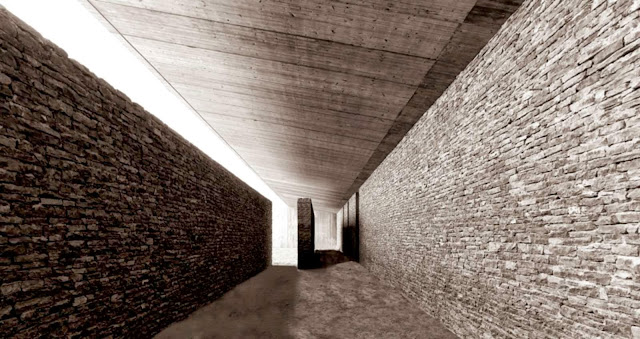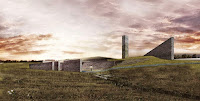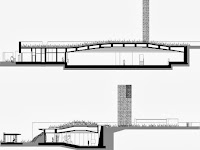Located in Buyuk Cekmece, a suburban neighborhood in the outskirts of Istanbul, aims to address the fundamental issues of designing a mosque by distancing itself from the current architectural discussions based on form and focusing solely on the essence of religious space.
The project site is located in a prairie landscape that is separated from the surrounding suburban gated communities by a busy highway. The high walls surrounding the park on the upper courtyard of the mosque depict a clear boundary between the chaotic outer world and the serene atmosphere of the public park.
The long canopy stretching out from the park becomes the only architectural element visible from the outside. The building is located below this canopy and can be accessed from a path from the upper courtyard through the park.
The building blends in completely with the topography and the outside world is left behind as one moves through the landscape, down the hill and in between the walls to enter the mosque. The interior of the mosque, a simple cave like space, becomes a dramatic and awe inspiring place to pray and be alone with God.
The slits and fractures along the Qiblah wall enhances the directionality of the prayer space and allows daylight to filter into the prayer hall. The project constantly plays off of the tension between man-made and natural.
The contrast between the natural stone stairs following the natural slope of the landscape and the thin reinforced concrete slab spanning over 6 meters to form the canopy helps enhance this dual relationship.
"There is no formal definition for a mosque in the Qu'ran," says Gülden Canol of Istanbul-based Emre Arolat Architects. "In Islam the emphasis is on the essence of a space rather than the form.
It does not dictate a form; it just has to be clean." High walls surrounding the upper courtyard of the mosque creates a clear boundary between the outside world and space of worship, while a long canopy of reinforced concrete extends 20 feet from the entrance is the only architectural element visible from outside the park.
The interior is simple and cavelike, not to mention underground. It's starkly different than the ornate interior of a classic mosque. One of the few quasi-ornaments, a prayer wall called the Qiblah wall, faces the direction of the Mecca and is adorned with slits and fractures to allow daylight to filter into the hall.
"We believe that with the proportions of the space and the daylight filtering in above the Qibla wall, praying here will provide a completely different but equally enchanting experience"says Canol.
Location: Buyuk Cekmece, Istanbul, Turkey
Architects: Emre Arolat Architects
Project Team: Leyla Kori (construction project); Uygar Yüksel, Oya Eskin Güvendi; Nil Aynalı, Taha Alkan, Ünal Ali Özger
Structural Project: Balkar Mühendislik
Mechanical Project: Setta Mühendislik
Electrical Project: HB TEknik
Lighting Project : Studio Lighting Design
Area: 1050 m2
Year: 2012
Client: Sancaklar Vakfı
Award: WorldArchitecture Festival 2013 Building Religion category
Architects: Emre Arolat Architects
Project Team: Leyla Kori (construction project); Uygar Yüksel, Oya Eskin Güvendi; Nil Aynalı, Taha Alkan, Ünal Ali Özger
Structural Project: Balkar Mühendislik
Mechanical Project: Setta Mühendislik
Electrical Project: HB TEknik
Lighting Project : Studio Lighting Design
Area: 1050 m2
Year: 2012
Client: Sancaklar Vakfı
Award: WorldArchitecture Festival 2013 Building Religion category



















